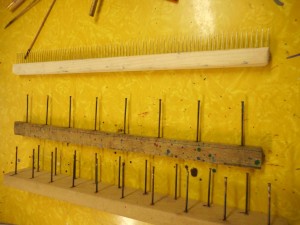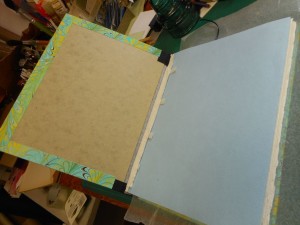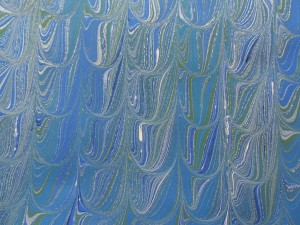I’ve been marbling on a regular basis for seven or eight years now and I’ve never had problems with my carrageenan until last summer. Problems with paint, with paper, with alum, but I didn’t even think about the carrageenan; it was always reliable. Last summer I had minor problems with it starting to break down after only a day or two, but I blamed it on the heat and moved on. Last week, I finally had time for my first marbling session in months and I was already to go when I hit a real stopper.
It went like this. The night before, I set up my marbling space, hung my drying lines, chose my paints, mixed the alum and mixed the carrageenan, just as I always do. Two and a half Tbsp. to a gallon of water, two gallons in all. I use distilled water because I have an incredible amount of stuff – iron, calcium, sulfur, and more – in my well water. As usual, I used the same blender to mix it and poured it into my marbling tray to sit overnight.
The next morning, I alummed some paper, mixed my paints and was ready to go. As soon as I skimmed the carrageenan, I could tell something was different. It was much thicker than it should have been and was very uneven. Using a stylus and my rake, I swirled them through the tray to try to even up the liquid. I decided to throw some paint to see what would happen and this is what I got:
-

-
First piece with lumpy carrageenan
-

-
Second
-

-
Third
-

-
Batch
I rather like the wildness in the first two pieces, but it’s not exactly marbling! As you might imagine, I was getting upset as skimming and stirring didn’t seem to help. Slowly I realized that there were big lumps of carrageenan throughout the tray and that was the problem. I thought about putting the carrageenan through the blender again or just tossing this batch and starting fresh the next day. I tried breaking the lumps with the rakes and that helped and I found that dragging the comb from the top of the tray to the bottom caught the lumps in the tines, so I started straining out the lumps and bit by bit the carrageenan became smoother and smoother.
-

-
Lumps at one end of tray
-

-
Carrageenan makes snow
-

-
Snow is small lumps of carragenan
-

-
Second batch
As I got rid of the lumps, marbling improved, but it was still very iffy. I was able to pull some pretty good pieces, but I was still straining lumps out after every skim. That created a problem of its own. It was thinning out the remaining carrageenan and, instead of crisp marbling edges, I was getting very soft fuzzy borders. I did finish up that day, but that night I took out an old packet of carrageenan from a different source and mixed a new batch for the next morning.
I still don’t really know why this disaster occurred. It could have been that I lost count and added an extra Tsbp. It could have been mixed too little or too much. It could have been due to cold temperatures that night. It could have been some contamination in the carrageenan powder. I just don’t know, but it was very frustrating!
Next morning I had brand new carrageenan and a brand new tray and marbling went well. In fact things were going so well that I kept on for another three days and I had lots of fun playing with overmarbling, ripples and got back in touch with marbling just for fun. Lots of pictures of my play.
-

-
My new marbling tray
-

-
It thought it was a frame, not a tray
-

-
Drying on the line
-

-
Drying
-

-
Oranges
-

-
Black & White
-

-

-

-
Pile of Papers
-

-
Another pile
-

-
Polar map
-

-
US Map (upside down)
-

-
What happens when you drop a wet piece
-

-
Overmarbled Flowers
-

-
Overmarbling
-

-
Overmarbling
-

-
Overmarbling
-

-
Ripples
-

-
Ripples
-

-
Ripples
-

-
Ripples
In total I had almost 100 pieces – good, bad and indifferent – by the end of the session.
Now, I want to do it again!
But, before that, I have to have a bunch of plumbing replaced right over my work area.
NOTE: Clear acrylic frames come in many sizes and make great, inexpensive marbling trays. Just remember to test how well they hold water before using. If they leak, plumber’s Goop or other sealant will seal the edges.
Like this:
Like Loading...















































































































































































































